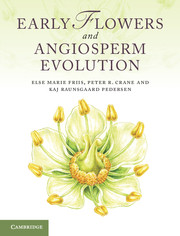Book contents
- Frontmatter
- Contents
- Preface
- 1 Introduction to angiosperms
- 2 The nature of the angiosperm fossil record
- 3 The environmental context of early angiosperm evolution
- 4 Stratigraphic framework and key areas for Cretaceous angiosperms
- 5 Angiosperms in context: extant and fossil seed plants
- 6 Origin and age of angiosperms
- 7 Phylogenetic framework and the assignment of fossils to extant groups
- 8 Fossils near the base of the angiosperm tree
- 9 Early fossil angiosperms of uncertain relationships
- 10 Early fossils of eumagnoliids
- 11 Fossils of monocots
- 12 Fossils of eudicots: early-diverging groups
- 13 Fossils of core eudicots: basal lineages
- 14 Fossils of core eudicots: rosids
- 15 Early fossils of eudicots: asterids
- 16 Patterns of structural diversification in angiosperm reproductive organs
- 17 History and evolution of pollination in angiosperms
- 18 History and evolution of dispersal in angiosperms
- 19 Vegetational context of early angiosperm diversification
- 20 The accumulation of angiosperm diversity
- References
- Index
9 - Early fossil angiosperms of uncertain relationships
Published online by Cambridge University Press: 07 September 2011
- Frontmatter
- Contents
- Preface
- 1 Introduction to angiosperms
- 2 The nature of the angiosperm fossil record
- 3 The environmental context of early angiosperm evolution
- 4 Stratigraphic framework and key areas for Cretaceous angiosperms
- 5 Angiosperms in context: extant and fossil seed plants
- 6 Origin and age of angiosperms
- 7 Phylogenetic framework and the assignment of fossils to extant groups
- 8 Fossils near the base of the angiosperm tree
- 9 Early fossil angiosperms of uncertain relationships
- 10 Early fossils of eumagnoliids
- 11 Fossils of monocots
- 12 Fossils of eudicots: early-diverging groups
- 13 Fossils of core eudicots: basal lineages
- 14 Fossils of core eudicots: rosids
- 15 Early fossils of eudicots: asterids
- 16 Patterns of structural diversification in angiosperm reproductive organs
- 17 History and evolution of pollination in angiosperms
- 18 History and evolution of dispersal in angiosperms
- 19 Vegetational context of early angiosperm diversification
- 20 The accumulation of angiosperm diversity
- References
- Index
Summary
In this chapter we describe plant fossils, mainly from the Early Cretaceous, that for various reasons cannot be assigned reliably to any extant group of angiosperms. In a few cases the relationship to angiosperms themselves is also uncertain (sections 9.1, 9.7). Some of these fossils are well-preserved floral structures, and the available information is reasonably extensive, but assignment to an extant order or family is precluded because the fossil has characters, or suites of characters, that are difficult to relate to a particular extant angiosperm group. In some instances the lack of relevant comparative data for extant taxa is also a problem. Other fossils considered in this chapter are dispersed floral parts, such as pollen, fruits and seeds. These provide further documentation of diversity among early angiosperms, but are difficult to assign to an extant group because they lack sufficient diagnostic characters.
In addition to the material discussed in this chapter there are many other fossils, especially from the Portugal and Potomac Group mesofossil floras, that remain to be described and for which relationships are not yet evaluated. A comprehensive account of these fossils is beyond the scope of this book. However, many of them probably represent early-diverging lineages of angiosperms of uncertain relationship that would probably also be included here.
- Type
- Chapter
- Information
- Early Flowers and Angiosperm Evolution , pp. 189 - 218Publisher: Cambridge University PressPrint publication year: 2011



